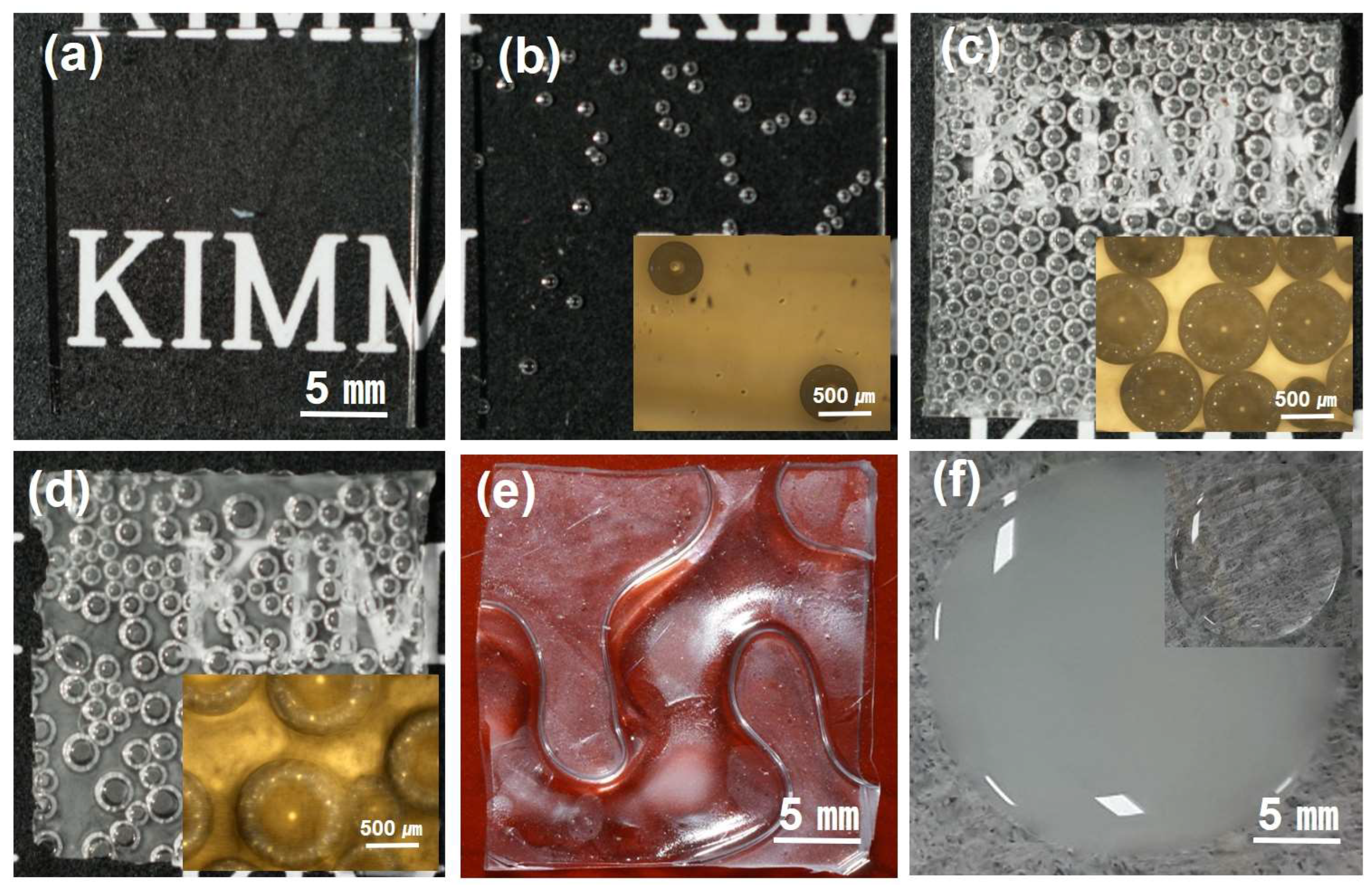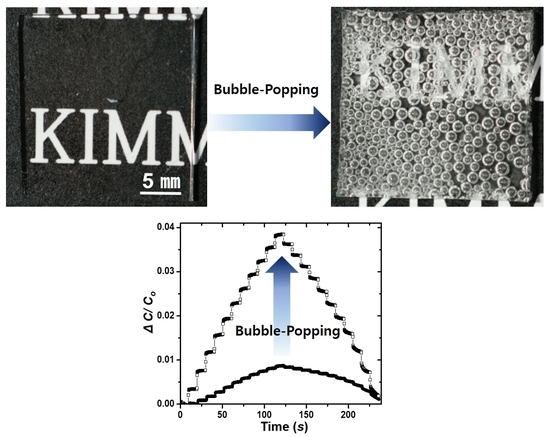Fabrication of Highly Sensitive Capacitive Pressure Sensors Using a Bubble-Popping PDMS
Abstract
:1. Introduction
2. Materials and Methods
2.1. PDMS with Pores inside the Elastomer
2.2. Characteristics of Pressure Sensors Made from Various PDMS Sheets
3. Results and Discussion
4. Conclusions
Author Contributions
Funding
Data Availability Statement
Acknowledgments
Conflicts of Interest
References
- Li, R.; Zhou, Q.; Bi, Y.; Cao, S.; Xia, X.; Yang, A.; Li, S.; Xia, X. Research progress of flexible capacitive pressure sensor for sensitivity enhancement approaches. Sens. Actuators A Phys. 2021, 321, 112425. [Google Scholar] [CrossRef]
- Chen, W.; Yan, X.; Wu, M.; Hou, S.; Yu, X.; Yu, J. Progress in achieving high-performance piezoresistive and capacitive flexible pressure sensors: A review. J. Mater. Sci. Technol. 2020, 43, 175–188. [Google Scholar] [CrossRef]
- Yu, Z.; Cai, G.; Liu, X.; Tang, D. Pressure-Based Biosensor Integrated with a Flexible Pressure Sensor and an Electrochromic Device for Visual Detection. Anal. Chem. 2021, 93, 2916–2925. [Google Scholar] [CrossRef]
- Huang, Y.; Fan, X.; Chen, S.-C.; Zhao, N. Emerging Technologies of Flexible Pressure Sensors: Materials, Modeling, Devices, and Manufacturing. Adv. Funct. Mater. 2019, 29, 1808509. [Google Scholar] [CrossRef]
- Gong, S.; Yap, L.W.; Zhu, Y.; Zhu, B.; Wang, Y.; Ling, Y.; Zhao, Y.; An, T.; Lu, Y.; Cheng, W. A Soft Resistive Acoustic Sensor Based on Suspended Standing Nanowire Membranes with Point Crack Design. Adv. Funct. Mater. 2020, 30, 1910717. [Google Scholar] [CrossRef]
- Souri, H.; Banerjee, H.; Jusufi, A.; Radacsi, N.; Stokes, A.A.; Park, I.; Sitti, M.; Amjadi, M. Wearable and Stretchable Strain Sensors: Materials, Sensing Mechanisms, and Applications. Adv. Intell. Syst. 2020, 2, 2000039. [Google Scholar] [CrossRef]
- Claver, U.P.; Zhao, G. Recent Progress in Flexible Pressure Sensors Based Electronic Skin. Adv. Eng. Mater. 2021, 23, 2001187. [Google Scholar] [CrossRef]
- Li, L.; Zheng, J.; Xhen, J.; Luo, Z.; Su, Y.; Tang, W.; Gao, X.; Li, Y.; Cao, C.; Liu, Q.; et al. Flexible Pressure Sensors for Biomedical Applications: From Ex Vivo to In Vivo. Adv. Mater. Interfaces 2020, 7, 2000743. [Google Scholar] [CrossRef]
- Sze, S.M. Semiconductor Device Physics and Technology, 2nd ed.; Chapter 6; Wiley and Sons: Hoboken, NJ, USA, 2001. [Google Scholar]
- Ruth, S.R.A.; Feig, V.R.; Tran, H.; Bao, Z. Microengineering Pressure Sensor Active Layers for Improved Performance. Adv. Funct. Mater. 2020, 30, 2003491. [Google Scholar] [CrossRef]
- Jang, Y.; Jo, J.; Woo, K.; Lee, S.-H.; Kwon, S.; Kim, H.; Lee, H.S. Fabrication of highly sensitive pieozocapacitive pressure sensors using a simple and inexpensive home milk frother. Phys. Rev. Appl. 2019, 11, 014037. [Google Scholar] [CrossRef]
- Ren, Z.; Nie, J.; Xu, L.; Jiang, T.; Chen, B.; Chen, X.; Wang, Z.L. Directly Visualizing Tactile Perception and Ultrasensitive Tactile Sensors by Utilizing Body-Enhanced Induction of Ambient Electromagnetic Waves. Adv. Funct. Mater. 2018, 28, 1805277. [Google Scholar] [CrossRef]
- Ding, Y.; Shi, Y.; Nie, J.; Ren, Z.; Li, S.; Wang, F.; Tian, J.; Chen, X.; Wang, Z.L. Thermochromic triboelectric nanogenerator enabling direct visualization of temperature change during operation. Chem. Eng. J. 2020, 388, 124369. [Google Scholar] [CrossRef]
- Ruth, S.R.A.; Beker, L.; Tran, H.; Feig, V.R.; Matsuhisa, N.; Bao, Z. Rational Design of Capacitive Pressure Sensors Based on Pyramidal Microstructures for Specialized Monitoring of Biosignals. Adv. Funct. Mater. 2020, 30, 1903100. [Google Scholar] [CrossRef]
- Baek, S.; Jang, H.; Kim, S.Y.; Jeong, H.; Han, S.; Jang, Y.; Kim, D.H.; Lee, H.S. Flexible piezocapacitive sensors based on wrinkled microstructures: Toward low-cost fabrication of pressure sensors over large areas. RCS Adv. 2017, 7, 39420. [Google Scholar] [CrossRef] [Green Version]
- Hao, T.; Zhang, L.; Ji, H.; Zhou, Q.; Feng, T.; Song, S.; Wang, B.; Liu, D.; Ren, Z.; Liu, W.; et al. A Stretchable, Transparent, and Mechanically Robust Silver Nanowire–Polydimethylsiloxane Electrode for Electrochromic Devices. Polymers 2023, 15, 2640. [Google Scholar] [CrossRef]
- Wexler, A.; Greenspan, L. Vapor pressure equation for water in range 0 to 100 °C. J. Res. Natl. Bur. Stand. A Phys. Chem. 1971, 75A, 213–230. [Google Scholar] [CrossRef]
- Schneider, F.; Draheim, J.; Kamberger, R.; Wallrabe, U. Process and material properties of polydimethylsiloxane (PDMS) for Optical MEMS. Sens. Actuators A Phys. 2009, 151, 95. [Google Scholar] [CrossRef]
- Aslanidis, E.; Skotadis, E.; Tsoukalas, D. Resistive crack-based nanoparticle strain sensors with extreme sensitivity and adjustable gauge factor, made on flexible substrates. Roy. Soc. Chem. 2021, 13, 3263. [Google Scholar] [CrossRef]
- Thirumal, M.; Khastgir, D.; Singha, N.K.; Manjunath, B.S.; Naik, Y.P. Effect of Foam Density on the Properties of Water Blown Rigid Polyurethane Foam. J. Appl. Polym. Sci. 2008, 108, 1810–1817. [Google Scholar] [CrossRef]
- Mannsfeld, S.C.; Tee, B.C.; Stoltenberg, R.M.; Chen CV, H.; Barman, S.; Muir, B.V.; Sokolov, A.N.; Reese, C.; Bao, Z. Highly sensitive flexible pressure sensors with microstructured rubber dielectric layers. Nat. Mater. 2010, 9, 859. [Google Scholar]
- Yang, J.; Luo, S.; Zhou, X.; Li, J.; Fu, J.; Yang, W.; Wei, D. Flexible, Tunable, and Ultrasensitive Capacitive Pressure Sensor with Microconformal Graphene Electrodes. ACS Appl. Mater. Interfaces 2019, 11, 14997–15006. [Google Scholar] [CrossRef] [PubMed]
- Ma, L.; Shuai, X.; Hu, Y.; Liang, X.; Zhu, P.; Sun, R.; Wong, C.-P. A highly sensitive and flexible capacitive pressure sensor based on a micro-arrayed polydimethylsiloxane dielectric layer. J. Mater. Chem. C 2018, 6, 13232–13240. [Google Scholar] [CrossRef]




Disclaimer/Publisher’s Note: The statements, opinions and data contained in all publications are solely those of the individual author(s) and contributor(s) and not of MDPI and/or the editor(s). MDPI and/or the editor(s) disclaim responsibility for any injury to people or property resulting from any ideas, methods, instructions or products referred to in the content. |
© 2023 by the authors. Licensee MDPI, Basel, Switzerland. This article is an open access article distributed under the terms and conditions of the Creative Commons Attribution (CC BY) license (https://creativecommons.org/licenses/by/4.0/).
Share and Cite
Jang, Y.; Jo, J.; Lee, S.-H.; Kim, I.; Lee, T.-M.; Woo, K.; Kwon, S.; Kim, H. Fabrication of Highly Sensitive Capacitive Pressure Sensors Using a Bubble-Popping PDMS. Polymers 2023, 15, 3301. https://doi.org/10.3390/polym15153301
Jang Y, Jo J, Lee S-H, Kim I, Lee T-M, Woo K, Kwon S, Kim H. Fabrication of Highly Sensitive Capacitive Pressure Sensors Using a Bubble-Popping PDMS. Polymers. 2023; 15(15):3301. https://doi.org/10.3390/polym15153301
Chicago/Turabian StyleJang, Yunseok, Jeongdai Jo, Seung-Hyun Lee, Inyoung Kim, Taik-Min Lee, Kyoohee Woo, Sin Kwon, and Hyunchang Kim. 2023. "Fabrication of Highly Sensitive Capacitive Pressure Sensors Using a Bubble-Popping PDMS" Polymers 15, no. 15: 3301. https://doi.org/10.3390/polym15153301





